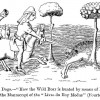 Pseudorabies primarily affects swine, but cattle, sheep and other mammals are susceptible to infection. Humans are not at risk. The superficial symptoms of this viral disease resemble rabies symptoms, thus the name pseudorabies. Although eliminated in commercial animals, feral swine populations in the United States continue to circulate the disease and provide a reservoir for outbreaks. Texas, Oklahoma, Florida, and Hawaii all have dense populations of feral swine with a high prevalence of pseudorabies. Feral swine, therefore, pose a serious risk to commercial swine operations, livestock, companion animals, and wildlife. This 4-page fact sheet was written by Samantha Wisely, and published by the UF Department of Wildlife Ecology and Conservation, August 2014.
Pseudorabies primarily affects swine, but cattle, sheep and other mammals are susceptible to infection. Humans are not at risk. The superficial symptoms of this viral disease resemble rabies symptoms, thus the name pseudorabies. Although eliminated in commercial animals, feral swine populations in the United States continue to circulate the disease and provide a reservoir for outbreaks. Texas, Oklahoma, Florida, and Hawaii all have dense populations of feral swine with a high prevalence of pseudorabies. Feral swine, therefore, pose a serious risk to commercial swine operations, livestock, companion animals, and wildlife. This 4-page fact sheet was written by Samantha Wisely, and published by the UF Department of Wildlife Ecology and Conservation, August 2014.
http://edis.ifas.ufl.edu/uw388
Category: Livestock
Can Maternal Colostrum Be Replaced by Commercial Products for Feeding Newborn Calves?
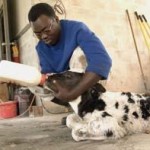 Colostrum management and feeding are critical for calf health, calves’ future productive life, and farm profitability. Current recommendations state that a calf needs to ingest at least 150–200 g of immunoglobulin G within two hours of birth, but when colostrum quality is poor or unavailable, colostrum replacer may be a suitable alternative. This 3-page fact sheet presents the results of a recent publication that evaluated the effects of feeding maternal colostrum, one dose of plasma-derived colostrum replacer, or one dose of colostrum-derived colostrum replacer on serum total protein, immunoglobulin G concentration, calf morbidity, calf mortality, and weight gain from birth to weaning. Written by Klibs N. Galvao, and published by the UF Department of Veterinary Medicine-Large Animal Clinical Sciences, May 2014.
Colostrum management and feeding are critical for calf health, calves’ future productive life, and farm profitability. Current recommendations state that a calf needs to ingest at least 150–200 g of immunoglobulin G within two hours of birth, but when colostrum quality is poor or unavailable, colostrum replacer may be a suitable alternative. This 3-page fact sheet presents the results of a recent publication that evaluated the effects of feeding maternal colostrum, one dose of plasma-derived colostrum replacer, or one dose of colostrum-derived colostrum replacer on serum total protein, immunoglobulin G concentration, calf morbidity, calf mortality, and weight gain from birth to weaning. Written by Klibs N. Galvao, and published by the UF Department of Veterinary Medicine-Large Animal Clinical Sciences, May 2014.
http://edis.ifas.ufl.edu/vm196
What Is the Most Cost-Effective Breeding Program for Lactating Dairy Cows: Timed AI, Estrous Detection, or a Combination of Both?
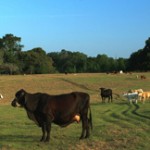 As any other business enterprise, the sustainability of a dairy farm is highly dependent on economics. Reproduction influences both milk production and number of replacement heifers available on a farm; therefore, reproductive efficiency becomes a key determinant of dairy cow profitability. Several parameters affect reproductive performance. This 4-page fact sheet presents information from recently published articles that looked at the economics of different reproductive programs for breeding dairy cows that use estrus detection only, timed AI only, or a combination of both. Written by Klibs N. Galvão, Gustavo M. Schuenemann, Eduardo S. Ribeiro, and Jose Eduardo P. Santos, and published by the UF Department of Veterinary Medicine-Large Animal Clinical Sciences, May 2014.
As any other business enterprise, the sustainability of a dairy farm is highly dependent on economics. Reproduction influences both milk production and number of replacement heifers available on a farm; therefore, reproductive efficiency becomes a key determinant of dairy cow profitability. Several parameters affect reproductive performance. This 4-page fact sheet presents information from recently published articles that looked at the economics of different reproductive programs for breeding dairy cows that use estrus detection only, timed AI only, or a combination of both. Written by Klibs N. Galvão, Gustavo M. Schuenemann, Eduardo S. Ribeiro, and Jose Eduardo P. Santos, and published by the UF Department of Veterinary Medicine-Large Animal Clinical Sciences, May 2014.
http://edis.ifas.ufl.edu/vm198
What Is the Most Cost-Effective Breeding Program for Breeding Heifers: Timed AI, Estrous Detection, or a Combination of Both?
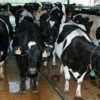 As any other business enterprise, the sustainability of a dairy farm is highly dependent on economics. In order to obtain a profitable return on assets, there is a constant need to maximize outputs and, oftentimes, to minimize inputs. Reproduction influences both milk production and number of replacement heifers available on a farm; therefore, reproductive efficiency becomes a key determinant of dairy cow profitability. This 3-page fact sheet presents information from recently published work that looked at the economics of different reproductive programs for breeding heifers that use timed AI only, estrus detection only, or a combination of both. Written by Klibs N. Galvão, Eduardo S. Ribeiro, and Jose Eduardo P. Santos, and published by the UF Department of Veterinary Medicine-Large Animal Clinical Sciences, May 2014.
As any other business enterprise, the sustainability of a dairy farm is highly dependent on economics. In order to obtain a profitable return on assets, there is a constant need to maximize outputs and, oftentimes, to minimize inputs. Reproduction influences both milk production and number of replacement heifers available on a farm; therefore, reproductive efficiency becomes a key determinant of dairy cow profitability. This 3-page fact sheet presents information from recently published work that looked at the economics of different reproductive programs for breeding heifers that use timed AI only, estrus detection only, or a combination of both. Written by Klibs N. Galvão, Eduardo S. Ribeiro, and Jose Eduardo P. Santos, and published by the UF Department of Veterinary Medicine-Large Animal Clinical Sciences, May 2014.
http://edis.ifas.ufl.edu/vm199
Can GnRH Be Used to Induce Ovulation Early in Lactation and Improve Fertility in Dairy Cows?
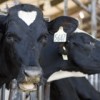 It is well established that early cyclicity results in increased pregnancy per artificial insemination and decreased time to pregnancy. But none of the previous studies has used synchronization programs such as the Presynch-Ovsynch as part of their reproductive management. This 2-page fact sheet presents the results of a recent paper that evaluated the effects of administration of GnRH at 17 ± 3 and 20 ± 3 DIM in Holstein dairy cows without a corpus luteum (CL) on induction of ovulation, uterine health, and reproductive outcomes. Written by Klibs N. Galvão, and published by the UF Department of Veterinary Medicine-Large Animal Clinical Sciences, July 2014.
It is well established that early cyclicity results in increased pregnancy per artificial insemination and decreased time to pregnancy. But none of the previous studies has used synchronization programs such as the Presynch-Ovsynch as part of their reproductive management. This 2-page fact sheet presents the results of a recent paper that evaluated the effects of administration of GnRH at 17 ± 3 and 20 ± 3 DIM in Holstein dairy cows without a corpus luteum (CL) on induction of ovulation, uterine health, and reproductive outcomes. Written by Klibs N. Galvão, and published by the UF Department of Veterinary Medicine-Large Animal Clinical Sciences, July 2014.
http://edis.ifas.ufl.edu/vm201
Targeting ADG of Developing Replacement Heifers Using Age and Body Weight
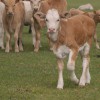 Heifer development continues to be one of the largest expenses to cow-calf operations, primarily due to cost of feed. Replacement heifers should be bred to calve at 24 months of age in order to maximize lifetime productivity of breeding females. Therefore, heifers should conceive at 15 months of age and achieve puberty at 13–14 months of age because heifers are infertile on the pubertal estrous cycle. This 4-page fact sheet was written by Phillip Lancaster and Cliff Lamb, and published by the UF Department of Animal Sciences, September 2014.
Heifer development continues to be one of the largest expenses to cow-calf operations, primarily due to cost of feed. Replacement heifers should be bred to calve at 24 months of age in order to maximize lifetime productivity of breeding females. Therefore, heifers should conceive at 15 months of age and achieve puberty at 13–14 months of age because heifers are infertile on the pubertal estrous cycle. This 4-page fact sheet was written by Phillip Lancaster and Cliff Lamb, and published by the UF Department of Animal Sciences, September 2014.
http://edis.ifas.ufl.edu/an305
When Should We Stop Breeding Dairy Cows?
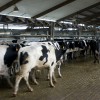 The decision of when to start and when to stop breeding cows during a lactation is often a challenging one for dairy producers. This 3-page fact sheet presents practical rules on how to determine when to stop breeding Holstein dairy cows based on persistency of milk production and break-even point for milk production. Written by Klibs N. Galvão and Albert De Vries, and published by the UF Department of Veterinary Medicine-Large Animal Clinical Sciences, July 2014.
The decision of when to start and when to stop breeding cows during a lactation is often a challenging one for dairy producers. This 3-page fact sheet presents practical rules on how to determine when to stop breeding Holstein dairy cows based on persistency of milk production and break-even point for milk production. Written by Klibs N. Galvão and Albert De Vries, and published by the UF Department of Veterinary Medicine-Large Animal Clinical Sciences, July 2014.
http://edis.ifas.ufl.edu/vm202
Should You Breed Cows during the Summer in the Southeastern United States? An Economic Analysis of a Dairy Herd in Florida
 In the southeast United States, since dairy cows experience decreased reproductive performance during the hot and humid summers, some dairy farmers delay breeding until the cooler fall. But there is no economic data to support this practice. This 3-page fact sheet presents the results of a recent paper that evaluated the effects that delaying breeding during the summer has on cow performance and profitability in Florida. Written by Klibs N. Galvão and Albert De Vries, and published by the UF Department of Veterinary Medicine-Large Animal Clinical Sciences, July 2014.
In the southeast United States, since dairy cows experience decreased reproductive performance during the hot and humid summers, some dairy farmers delay breeding until the cooler fall. But there is no economic data to support this practice. This 3-page fact sheet presents the results of a recent paper that evaluated the effects that delaying breeding during the summer has on cow performance and profitability in Florida. Written by Klibs N. Galvão and Albert De Vries, and published by the UF Department of Veterinary Medicine-Large Animal Clinical Sciences, July 2014.
http://edis.ifas.ufl.edu/vm195
Is It Worth Switching from Natural Service to Artificial Insemination? A Comparison of Reproductive Performance and Profitability in Dairy Herds
 Reproductive efficiency is a key determinant of dairy cow profitability. A considerable portion of dairy producers in the United States still use NS in at least part of their breeding program. This 3-page fact sheet presents the results of papers that compared the reproductive performance and profitability of dairy cows submitted to natural service or a combination of timed AI and natural service. Written by Klibs N. Galvão, Eduardo S. Ribeiro, and Jose Eduardo P. Santos, and published by the UF Department of Veterinary Medicine-Large Animal Clinical Sciences, June 2014.
Reproductive efficiency is a key determinant of dairy cow profitability. A considerable portion of dairy producers in the United States still use NS in at least part of their breeding program. This 3-page fact sheet presents the results of papers that compared the reproductive performance and profitability of dairy cows submitted to natural service or a combination of timed AI and natural service. Written by Klibs N. Galvão, Eduardo S. Ribeiro, and Jose Eduardo P. Santos, and published by the UF Department of Veterinary Medicine-Large Animal Clinical Sciences, June 2014.
http://edis.ifas.ufl.edu/vm200
Should Genetics Be Blamed for High Incidence of Uterine Disease in Dairy Cows?
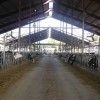 Uterine diseases are highly prevalent in high-producing dairy cows. They have been associated with decreased pregnancy per artificial insemination (AI), extended interval to pregnancy, increased culling, and economic losses. This 3-page fact sheet presents the results of a recent paper that examined how alterations on the TLR genes, which control innate immune response, affect the susceptibility to uterine diseases. Written by Klibs N. Galvão, Christopher M. Seabury, and Pablo Pinedo, and published by the UF Department of Veterinary Medicine-Large Animal Clinical Sciences, May 2014.
Uterine diseases are highly prevalent in high-producing dairy cows. They have been associated with decreased pregnancy per artificial insemination (AI), extended interval to pregnancy, increased culling, and economic losses. This 3-page fact sheet presents the results of a recent paper that examined how alterations on the TLR genes, which control innate immune response, affect the susceptibility to uterine diseases. Written by Klibs N. Galvão, Christopher M. Seabury, and Pablo Pinedo, and published by the UF Department of Veterinary Medicine-Large Animal Clinical Sciences, May 2014.
http://edis.ifas.ufl.edu/vm197
Cow Math: Using Weaning Weight to Estimate Cowherd Productivity
 “You can’t get where you’re going unless you know where you are.”
“You can’t get where you’re going unless you know where you are.”
The ability to measure performance is a key component in all beef cow operations, and measuring production efficiency is becoming increasingly important. Regardless of size, producers must be able to identify the current status of their operation in order to make adjustments toward improvement. Identifying and culling the cows within the herd that are less efficient at producing a weaned calf in the environment and management system used on the ranch can be a powerful tool to improve the herd. This 8-page fact sheet was written by Phillip Lancaster and John Arthington, and published by the UF Department of Animal Science, April 2014.
http://edis.ifas.ufl.edu/an129
The Florida Bull Test, 2013-2014
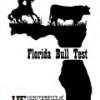 The 2013-2014 Florida Bull Test was a 112-day performance test and a breeding soundness evaluation of each bull that qualified for the auction. Table 1 summarizes feed efficiency data; Table 2 individual feed intake and feed efficiency; and Table 3 individual animal performance. This 10-page fact sheet was written by Vitor R. G. Mercadante, G. Cliff Lamb, and Nicolas DiLorenzo, and published by the UF Department of Animal Sciences, May 2014.
The 2013-2014 Florida Bull Test was a 112-day performance test and a breeding soundness evaluation of each bull that qualified for the auction. Table 1 summarizes feed efficiency data; Table 2 individual feed intake and feed efficiency; and Table 3 individual animal performance. This 10-page fact sheet was written by Vitor R. G. Mercadante, G. Cliff Lamb, and Nicolas DiLorenzo, and published by the UF Department of Animal Sciences, May 2014.
http://edis.ifas.ufl.edu/an301
The Interaction of Nutrition and Health in Beef Cows
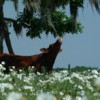 In cattle, all physiological processes in the body, including the immune system, are influenced by the cattle’s nutritional status. Therefore, the past and present nutritional status serves as an immune function modulator in cattle that can influence the performance and reproduction of beef cattle. This 6-page fact sheet was written by Matt Hersom, and published by the UF Department of Animal Sciences, June 2014.
In cattle, all physiological processes in the body, including the immune system, are influenced by the cattle’s nutritional status. Therefore, the past and present nutritional status serves as an immune function modulator in cattle that can influence the performance and reproduction of beef cattle. This 6-page fact sheet was written by Matt Hersom, and published by the UF Department of Animal Sciences, June 2014.
http://edis.ifas.ufl.edu/an292
Cattle Fencing BMP Can Reduce Phosphorus Loads from Florida Ranches
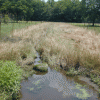 BMPs are an important tool in helping the state and individual landowners protect and enhance state’s waters. Given the water quality issues facing Lake Okeechobee and other sensitive water bodies, the importance of BMP implementation has increased since their official establishment as part of the FWRA. In order to ensure that BMPs are reducing nutrient loadings, on-farm research is needed to verify BMP effectiveness. A four-year study was conducted to evaluate the effectiveness of the cow/calf stream fencing BMP. The study concluded that the BMP did reduce the amount of P being discharged from the ranch. This BMP should continue to be included in the cow/calf BMP manual, and, hopefully, its widespread implementation will help the state in meeting its TMDLs. This 3-page fact sheet was written by Sanjay Shukla, Wendy D. Graham, Alan Hodges, and James M. Knowles, and published by the UF Department of Agricultural and Biological Engineering, May 2014.
BMPs are an important tool in helping the state and individual landowners protect and enhance state’s waters. Given the water quality issues facing Lake Okeechobee and other sensitive water bodies, the importance of BMP implementation has increased since their official establishment as part of the FWRA. In order to ensure that BMPs are reducing nutrient loadings, on-farm research is needed to verify BMP effectiveness. A four-year study was conducted to evaluate the effectiveness of the cow/calf stream fencing BMP. The study concluded that the BMP did reduce the amount of P being discharged from the ranch. This BMP should continue to be included in the cow/calf BMP manual, and, hopefully, its widespread implementation will help the state in meeting its TMDLs. This 3-page fact sheet was written by Sanjay Shukla, Wendy D. Graham, Alan Hodges, and James M. Knowles, and published by the UF Department of Agricultural and Biological Engineering, May 2014.
http://edis.ifas.ufl.edu/ae501
Anaerobic Digesters for Manure Management for Livestock Operations
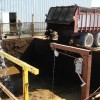 Livestock wastes can be important sources of nutrients for crops, but manure must be managed properly to prevent loss of nutrients to the environment in air or ground and/or surface water. Stabilization of manure is important prior to successfully recycling the organic material back to arable lands. Methods for stabilizing livestock wastes include composting, aerobic digestion, anaerobic digestion, lime stabilization, and heat drying. The stabilization process reduces the organic matter and water contents, unpleasant odors, concentrations of pathogenic microorganisms, and weed seeds. Anaerobic digestion (AD), which is the topic of this fact sheet, also results in the production of renewable energy in the form of methane-rich biogas. This 10-page fact sheet informs farmers and Extension agents about types of anaerobic digester systems used in the United States with various manure-handling systems. It points out digester systems currently being used in Florida and the benefits of managing livestock manure with a digester system. Written by Rishi Prasad, George Hochmuth, and Ann C. Wilkie, and published by the UF Department of Soil and Water Science, March 2014.
Livestock wastes can be important sources of nutrients for crops, but manure must be managed properly to prevent loss of nutrients to the environment in air or ground and/or surface water. Stabilization of manure is important prior to successfully recycling the organic material back to arable lands. Methods for stabilizing livestock wastes include composting, aerobic digestion, anaerobic digestion, lime stabilization, and heat drying. The stabilization process reduces the organic matter and water contents, unpleasant odors, concentrations of pathogenic microorganisms, and weed seeds. Anaerobic digestion (AD), which is the topic of this fact sheet, also results in the production of renewable energy in the form of methane-rich biogas. This 10-page fact sheet informs farmers and Extension agents about types of anaerobic digester systems used in the United States with various manure-handling systems. It points out digester systems currently being used in Florida and the benefits of managing livestock manure with a digester system. Written by Rishi Prasad, George Hochmuth, and Ann C. Wilkie, and published by the UF Department of Soil and Water Science, March 2014.
http://edis.ifas.ufl.edu/ss615
Goat Parasite Control: General Guidelines
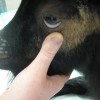 Gastrointestinal (GI) parasitism is the leading cause of death and decreased production in goats. At least 48% of farms in the southeast have parasites that are resistant to all classes of dewormers. While there is no one-size-fits-all recommendation for parasite control, the information in this fact sheet is provided for on-farm use. Contact your veterinarian for specific recommendations. Information was provided by Dr. Sarah Reuss of the UF Large Animal Medicine Service. This 2-page fact sheet was written by Sarah Reuss, and published by the UF Department of Animal Sciences, February 2014.
Gastrointestinal (GI) parasitism is the leading cause of death and decreased production in goats. At least 48% of farms in the southeast have parasites that are resistant to all classes of dewormers. While there is no one-size-fits-all recommendation for parasite control, the information in this fact sheet is provided for on-farm use. Contact your veterinarian for specific recommendations. Information was provided by Dr. Sarah Reuss of the UF Large Animal Medicine Service. This 2-page fact sheet was written by Sarah Reuss, and published by the UF Department of Animal Sciences, February 2014.
http://edis.ifas.ufl.edu/an294
Intestinal and Tracheal Parasites of Poultry
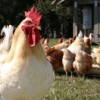 A parasite is defined as an animal or plant that derives sustenance and/or protection by living in or on another animal or plant called the host. Intestinal and tracheal parasites of poultry are commonly referred to as “worms,” although this term is technically not correct. These parasites can cause chickens in a flock to appear unthrifty, which often leads to secondary complications. In some cases, the parasites can cause mortality in the flock. Frequent inspection of the flock for signs of illness is the best management tool for identifying when these parasites are a problem. This 3-page fact sheet was written by Gary D. Butcher and Michael A. Davis, and published by the UF Department of Animal Sciences, April 2014.
A parasite is defined as an animal or plant that derives sustenance and/or protection by living in or on another animal or plant called the host. Intestinal and tracheal parasites of poultry are commonly referred to as “worms,” although this term is technically not correct. These parasites can cause chickens in a flock to appear unthrifty, which often leads to secondary complications. In some cases, the parasites can cause mortality in the flock. Frequent inspection of the flock for signs of illness is the best management tool for identifying when these parasites are a problem. This 3-page fact sheet was written by Gary D. Butcher and Michael A. Davis, and published by the UF Department of Animal Sciences, April 2014.
http://edis.ifas.ufl.edu/aa078
Estimando la Cantidad de Forraje en Campos de Heno y Potreros
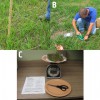 El forraje sirve como fuente primaria de nutrientes para la industria ganadera en Florida. El uso eficiente de esta fuente nutricional es crítico para la supervivencia de los agricultores y rancheros de dicho estado. El estimar la cantidad de forraje en potreros puede proveer información útil a la hora de tomar decisiones acerca del manejo de nuestros recursos. Debe de haber suficiente material en el predio para justificar el costo de utilizar el equipo para cosechar (por ejemplo, precio de compra del equipo, renta, costo del combustible a invertirse, y el costo de la mano de obra). Sin esta información, el predio debe ser sometido a pastoreo. Esta publicación contiene las instrucciones para la implementación de un método simple que nos permite determinar la cantidad aproximada de forraje en campos de heno y potreros.This 2-page fact sheet was written by T. Wilson, C. Sanders, J. Breman, y L. Sollenberger. Traducido por J. Bosques, and published by the UF Department of Agronomy, January 2014.
El forraje sirve como fuente primaria de nutrientes para la industria ganadera en Florida. El uso eficiente de esta fuente nutricional es crítico para la supervivencia de los agricultores y rancheros de dicho estado. El estimar la cantidad de forraje en potreros puede proveer información útil a la hora de tomar decisiones acerca del manejo de nuestros recursos. Debe de haber suficiente material en el predio para justificar el costo de utilizar el equipo para cosechar (por ejemplo, precio de compra del equipo, renta, costo del combustible a invertirse, y el costo de la mano de obra). Sin esta información, el predio debe ser sometido a pastoreo. Esta publicación contiene las instrucciones para la implementación de un método simple que nos permite determinar la cantidad aproximada de forraje en campos de heno y potreros.This 2-page fact sheet was written by T. Wilson, C. Sanders, J. Breman, y L. Sollenberger. Traducido por J. Bosques, and published by the UF Department of Agronomy, January 2014.
http://edis.ifas.ufl.edu/ag379
Does the Method of Castration Affect Calf Performance?
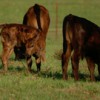 This 4-page fact sheet discusses the purpose of castration in male calves as well as the different methods used to castrate. Most methods of castration cause a certain amount of pain and stress for calves, which can affect calf performance. UF/IFAS researchers recently tested different methods of castration in calves to determine the effects of each method on calf health and performance. This publication presents these results. Written by Trey Warnock, Matt Hersom, and Todd Thrift, and published by the UF Department of Animal Sciences, December 2013.
This 4-page fact sheet discusses the purpose of castration in male calves as well as the different methods used to castrate. Most methods of castration cause a certain amount of pain and stress for calves, which can affect calf performance. UF/IFAS researchers recently tested different methods of castration in calves to determine the effects of each method on calf health and performance. This publication presents these results. Written by Trey Warnock, Matt Hersom, and Todd Thrift, and published by the UF Department of Animal Sciences, December 2013.
http://edis.ifas.ufl.edu/an291
Identification and Control of Coral Ardisia (Ardisia crenata): A Potentially Poisonous Plant.
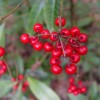 Coral ardisia, also known as coral berry, spice berry, and scratchthroat, was introduced to Florida in the early 1900’s for ornamental purposes. Since then, it has escaped cultivation, and it is found in hardwood hammocks and other moist, natural-wooded areas and grazing lands. Although there is no published literature supporting the theory that coral ardisia is toxic, it is suspected that the berries and/or foliage are poisonous to livestock, pets, and humans. This 3-page fact sheet was written by B. A. Sellers, Sarah Lancaster, K. A. Langeland, J.A. Ferrell, Michael Meisenberg, and J. Walter, and published by the UF Department of Agronomy, November 2013.
Coral ardisia, also known as coral berry, spice berry, and scratchthroat, was introduced to Florida in the early 1900’s for ornamental purposes. Since then, it has escaped cultivation, and it is found in hardwood hammocks and other moist, natural-wooded areas and grazing lands. Although there is no published literature supporting the theory that coral ardisia is toxic, it is suspected that the berries and/or foliage are poisonous to livestock, pets, and humans. This 3-page fact sheet was written by B. A. Sellers, Sarah Lancaster, K. A. Langeland, J.A. Ferrell, Michael Meisenberg, and J. Walter, and published by the UF Department of Agronomy, November 2013.
http://edis.ifas.ufl.edu/ag281